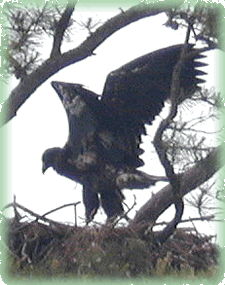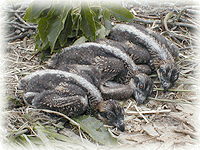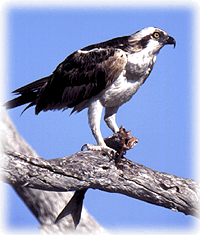 |
|
|||
Objectives Students will be able to:
Modeling clay in assorted colors or 16 small styrofoam balls in assorted colors 16 large clear bags 16 three-foot lengths of string Toothpicks 23 students Making Connections Just like the rest of New Jersey’s wildlife, in particular the birds of prey, those that live along the Delaware estuary are subject to the impacts of society. One of the most well known examples that typify human impact on wildlife is the effect of DDT, a widespread pesticide, on the fertility of birds of prey. Throughout New Jersey, peregrine falcon, osprey and bald eagle suffered severe loss in population due to the devastating impact of DDT in the food chain. This toxin built up (bioaccumulated) in the fatty tissue of these birds and caused a decrease in their egg shell density. As a result, these birds experienced a dramatic increase in embryo mortality which led to these species becoming endangered. This problem was (and is) especially prevalent along the Delaware Bay and its tributaries from along the southern Bayshore since these areas harbor a significant proportion of the state’s population of these birds. This is mostly due to the fact that substantial available habitats exist in the Down Jersey region for these magnificent creatures. Background The natural shoreline of the Delaware Bay has been changed drastically by humans, from forests and tidal wetlands to residential communities, industrial areas, ports, and cities. Human activity has also dumped pollutants of all kinds into the local waters from quickly biodegradable organic pollutants like sewage to non-biodegradable chemical pollutants like the pesticide DDT. This is a problem in estuaries, which, by nature, trap pollutants. Sewage and nutrient pollution result in algae blooms, low dissolved oxygen and pathogenic bacteria, but the effects are relatively short-term provided the source of pollution is eliminated. More refractory materials remain in the estuary for very long periods of time because they are not used up or degraded, and they are either buried as they bind with sediment particles and sink to the bottom, or they enter the food web. Chemicals that initially enter the food web through air, water, or sediment will accumulate at one level of the food web. Water-soluble chemicals will accumulate in food webs until they reach a concentration in organisms that is in balance with the environment. Fat-soluble chemicals bind to fatty tissues in organisms as they are ingested. Because organisms at higher trophic levels must eat a large number of organisms at lower trophic levels to get enough food, these chemicals tend to become bioaccumulated in organisms’ bodies as they get passed up the food chain. Procedure Warm Up Talk about the demise of the birds of prey in New Jersey. If possible, view the film Back from the Brink available from the Endangered and Nongame Species program at (609) 292-9400. Also, review the portion of the video Down Jersey that focuses on the osprey. Discuss with the students why the osprey is a threatened species in New Jersey. Why is it necessary to erect nesting platforms for them?
Wrap Up Think about the concept of a food pyramid. Discuss the different pathways by which energy is lost from one trophic level to the next (i.e., why larger organisms need to eat more smaller organisms to get the amount of food they need to survive, grow and reproduce.) Discuss how this influences biomagnification. Have the colored balls represent the pesticide DDT. Have students research or read about how the biomagnification of DDT in food webs has affected birds. When the osprey has all the DDT in its body (pouch), discuss the plight of the osprey in the area of the Delaware estuary and in fact, all of New Jersey. What has been done to help alleviate these problems? How has the osprey made a comeback in the state and in particular, the Down Jersey region? Action Students could create a display/ bulletin board that explains the osprey (bird of prey) dilemma in New Jersey. How did these birds of prey become endangered? What is being done to manage their populations? For how long will we and our environment feel the effects of DDT? Using the plans for building an osprey platform included, have the students have their own Osprey Tower Raising. Contact Citizens United and the NJDEP Endangered and Nongame Species Program for more information and how to get involved in local efforts to help these threatened birds. Assessment Participation in classroom discussions and simulation of bioaccumulation. Students could be asked to write a summary and definition of bioaccumulation. Include a diagram and a food web to illustrate how this occurs. Extensions See Action at left. Please download the PDF for the Lesson Plan. NJDEP, Endangered and Nongame Species Program Wetlands Institute |
|||

 One class period
One class period Materials
Materials  The Activity
The Activity